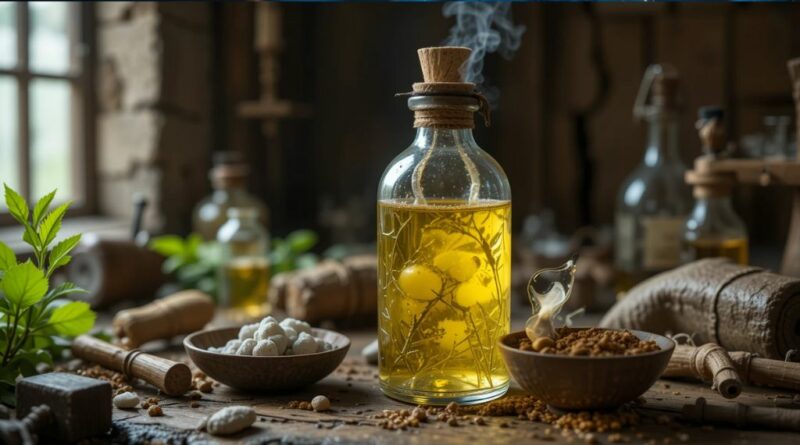The Medieval Remedy That’s Stunning Scientists
In the realm of medical science, antibiotic resistance poses a sustained challenge. However, researchers have discovered an unlikely ally in the fight against superbugs: a thousand-year-old recipe from medieval England that’s proving more effective than modern antibiotics.
The Remarkable Discovery
Deep within the British Library’s collection lies a manuscript that has captured the attention of microbiologists worldwide. Bald’s Leechbook, a 10th-century Anglo-Saxon medical text, contains a recipe that researchers at the University of Nottingham have proven can eliminate up to 90% of MRSA—one of the most dangerous antibiotic-resistant bacteria known to medicine.
The remedy, known as “Bald’s eye salve,” has been found to kill the modern superbug MRSA, demonstrating that medieval physicians possessed a sophisticated understanding of antimicrobial treatment that modern science is only beginning to appreciate.
The Ancient Recipe That Modern Science Can’t Explain
The ingredients of Bald’s eye salve read like a medieval shopping list: garlic, onion (or another allium), wine, and bovine bile. These everyday components must be crushed together and left to stand for nine days in a bronze vessel before use. What makes this remedy truly extraordinary is that none of the ingredients work individually—only the complete, faithfully reconstructed mixture demonstrates potent antibacterial activity.
Researchers now have replicated data showing that Bald’s eye salve kills up to 90% of MRSA bacteria in wound biopsies from mouse models, with the bactericidal effect attributed not to a single ingredient but to the combination used and brewing methods.
The medieval text describes the remedy as a treatment for a “wen”—a cyst or lump in the eye—but modern testing has revealed its broader antimicrobial potential. The recipe’s effectiveness extends beyond individual bacteria to tackle biofilms, the dense bacterial colonies that form protective barriers and are notoriously difficult to treat with conventional antibiotics.
The Science Behind the Ancient Wisdom
The research, published in the journal mBio, represents a groundbreaking collaboration between medieval historians and microbiologists. The team meticulously followed the original Anglo-Saxon instructions, including the use of a bronze vessel and the nine-day brewing period, discovering that these seemingly mystical elements are crucial to the remedy’s effectiveness.
What’s particularly fascinating is that the medieval physicians understood something that modern medicine is still grappling with: the power of combination therapy. While individual components like garlic have known antimicrobial properties, the synergistic effect of the complete mixture far exceeds what any single ingredient could achieve.
The University of Warwick has also conducted research showing that medieval medicine remedies could provide new treatments for modern infections, demonstrating the remedy’s effectiveness against five different bacteria that cause biofilm infections.
A Growing Crisis Demands Ancient Solutions
The timing of this discovery couldn’t be more critical. Antimicrobial resistance (AMR) has become one of the most pressing health challenges of our time. Recent studies published in The Lancet forecast that more than 39 million people could die from antibiotic-resistant infections between now and 2050, with annual death tolls reaching 1.91 million by 2050 if remediation measures are not implemented.
The World Health Organisation has identified AMR as one of the top ten global public health threats, with drug-resistant diseases potentially causing 10 million deaths annually by 2050 if no action is taken. In this context, the discovery that a medieval remedy can outperform modern antibiotics represents more than academic curiosity—it offers genuine hope for addressing a looming medical catastrophe.
The Broader Implications for Medical Research
The success of Bald’s eye salve is prompting researchers to reconsider historical medical texts as potential sources of new treatments. Medieval physicians, working without modern laboratory equipment, developed treatments through careful observation and experimentation over generations. Their empirical approach, refined through centuries of use, may have identified effective combinations that modern pharmaceutical development has overlooked.
This research also highlights the importance of preserving and studying historical medical knowledge. The British Library’s digitisation efforts have made manuscripts like Bald’s Leechbook accessible to researchers worldwide, enabling discoveries that might otherwise remain hidden in ancient texts.
Challenges and Future Directions
While the results are promising, significant challenges remain before this medieval remedy could become a modern treatment. Researchers must identify the specific mechanisms that make the combination so effective, standardise production methods, and conduct extensive clinical trials to ensure safety and efficacy in humans.
The complexity of recreating the exact conditions described in the medieval text—from the bronze vessel to the precise timing—presents manufacturing challenges that must be overcome. Additionally, regulatory frameworks for approving treatments based on historical remedies are still evolving.
Learning from the Past to Secure the Future
The story of Bald’s eye salve demonstrates that innovation doesn’t always mean starting from scratch. Sometimes, the most revolutionary advances come from looking backwards, learning from the accumulated wisdom of previous generations, and applying modern scientific methods to ancient knowledge.
As we face the growing threat of antibiotic resistance, this medieval remedy reminds us that effective solutions may already exist, waiting to be rediscovered in the pages of history. The collaboration between medievalists and microbiologists that made this discovery possible suggests that interdisciplinary approaches—combining historical scholarship with cutting-edge science—may be key to solving some of our most pressing medical challenges.
The humble ingredients in Bald’s eye salve—garlic, onion, wine, and bile—prove that sometimes the most powerful medicines come from the simplest sources. As research continues, this thousand-year-old recipe may well become the foundation for the next generation of antimicrobial treatments, demonstrating that in the fight against superbugs, our oldest allies might also be our most effective ones.
We’d like to hear your questions or comments on today’s topic!
For more articles like this one, click here.
Thought for the day:
“Self-preservation is the first law of nature.” Samuel Butler



